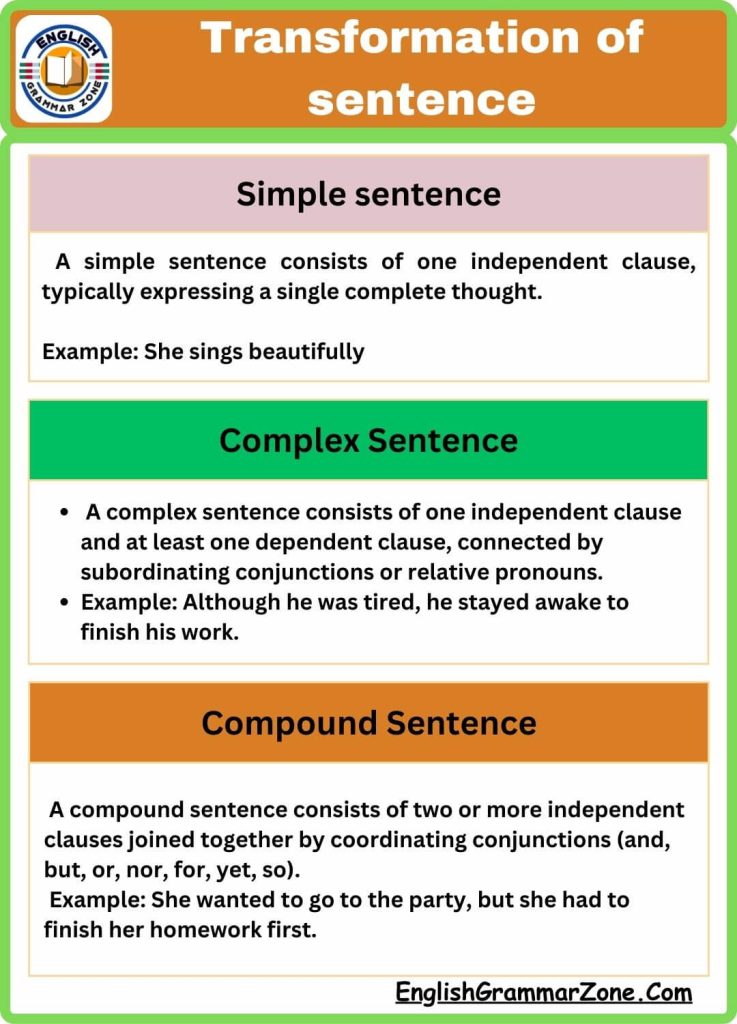Understanding the difference between simple, complex, and compound sentences is key to improving your writing and communication skills. In this exercise, we’ll break down these three types of sentences in a way that’s easy to grasp, especially if you’re just starting to explore sentence structures. By the end of this post, you’ll have a solid understanding of how to identify and construct simple, complex, and compound sentences, giving you the tools to write with clarity and variety.
Simple complex and compound sentence
Simple complex and compound sentence
Transformation of sentence
Simple sentence
A simple sentence consists of one independent clause, typically expressing a single complete thought.
Example: She sings beautifully
Complex Sentence
A complex sentence consists of one independent clause and at least one dependent clause, connected by subordinating conjunctions or relative pronouns.
Example: Although he was tired, he stayed awake to finish his work.
Compound Sentence
A compound sentence consists of two or more independent clauses joined together by coordinating conjunctions (and, but, or, nor, for, yet, so).
Example: She wanted to go to the party, but she had to finish her homework first.
1. Simple Sentence
Definition: A simple sentence is the most basic type of sentence. It consists of one independent clause, which means it contains a subject and a predicate (verb), and it expresses a complete thought.
Key Points:
- Structure: Subject + Verb (+ Object/Complement)
- Purpose: Conveys a single idea clearly and directly.
Example:
- “She sings beautifully.”
- Explanation: This sentence has a subject “She” and a verb “sings”. It expresses a complete thought about her singing ability.
2. Complex Sentence
Definition: A complex sentence contains one independent clause and at least one dependent clause. A dependent clause cannot stand alone as a complete sentence because it does not express a complete thought on its own.
Key Points:
- Structure: Independent Clause + Dependent Clause (introduced by subordinating conjunctions like although, because, if, when, etc.)
- Purpose: Shows relationships between ideas, often explaining reasons or conditions.
Example:
- “Although he was tired, he stayed awake to finish his work.”
- Explanation: This sentence has an independent clause “he stayed awake to finish his work” and a dependent clause “Although he was tired”. The dependent clause modifies the independent clause by expressing a condition.
3. Compound Sentence
Definition: A compound sentence consists of two or more independent clauses joined together by coordinating conjunctions (and, but, or, nor, for, yet, so). Each clause in a compound sentence could stand alone as a separate sentence.
Key Points:
- Structure: Independent Clause + Coordinating Conjunction + Independent Clause
- Purpose: Connects related ideas or actions, often showing contrast or adding information.
Example:
- “She wanted to go to the party, but she had to finish her homework first.”
- Explanation: This sentence has two independent clauses: “She wanted to go to the party” and “she had to finish her homework first”. The coordinating conjunction “but” connects these two clauses, showing a contrast between her desires and her responsibilities.
FAQs on Simple complex and compound sentence
- What is a simple sentence?
- A simple sentence contains just one independent clause, with a subject and a predicate. Example: She reads books.
- What makes a sentence complex?
- A complex sentence has one independent clause and at least one dependent clause. Example: She reads books because she loves stories.
- How is a compound sentence different from a simple sentence?
- A compound sentence connects two independent clauses with a conjunction (like “and,” “but,” or “or”). Example: She reads books, and he watches movies.
- Can a sentence be both compound and complex?
- Yes! A compound-complex sentence has at least two independent clauses and one or more dependent clauses. Example: She reads books because she loves stories, and he watches movies when he has time.
- How do I know when to use a complex sentence?
- Use a complex sentence when you want to show a relationship between ideas, like cause and effect, time, or contrast. Example: She studied hard because she wanted to pass the test.

